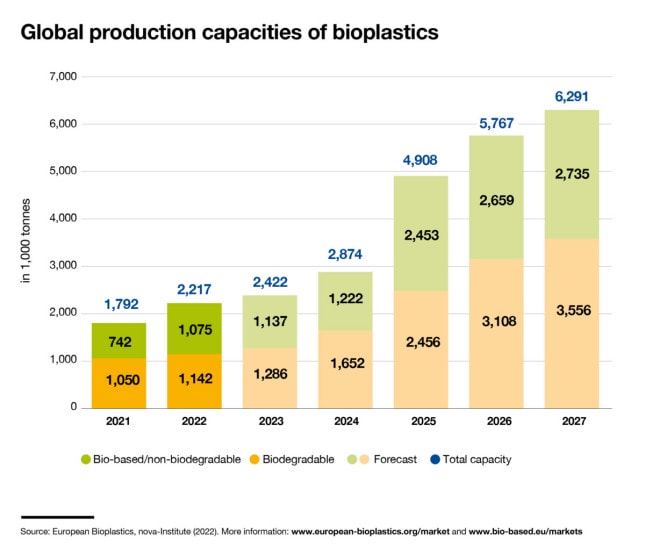Bioplastics: The ‘Best Kept Secret’ in Kansas Sunflower State is a Leader in Plant-Based Polymers
Published January 24th, 2023 at 6:00 AM
Above image credit: Mike Parker uses the small scale machinery at Green Dot's research and development lab to test new bioplastics materials. (Cami Koons | Flatland)“There’s a great future in plastics.”
Or so Benjamin Braddock, the protagonist in the classic movie “The Graduate,” was told in the late 1960s.
Each year, almost 400 million tons of plastic are produced around the world, mostly made from fossil fuels. Those plastics become permanent fixtures of the environment.
While the plastics industry remains profitable, today’s graduates might be wise to consider bioplastics instead.
In 2022, about 2.2 million tons of the world’s plastics were made from plant-based materials, according to a study by European Bioplastics. The same study predicts that the production of bioplastics will nearly triple by 2027.
Kansas has staked out a key role in the bioplastics revolution. One of the top bioplastics research labs is at Pittsburg State University, and a thriving bioplastics material company is based in Emporia.
As the bioplastics industry scales up, manufacturers, companies and consumers are needed to embrace the waste-reducing commodity.

What Are Bioplastics?
Bioplastics or plant-based plastics are either fully or partially derived from organic materials. Typically, bioplastics are made from things like soybean oil, corn husks, plant starches or mixed with a filler like wood pellets.
The plant-based materials can look and perform just like traditional petroleum plastics and can be used to make anything — phone cases, forks, chairs, alpine skis, garbage liners – the list goes on.
All bioplastics have some plant material, but not all bioplastics are compostable, or able to return nutrients to the soil as they break down.
Green Dot Bioplastics, a company based in Emporia, Kansas, makes bioplastic pellets (both compostable and not) that are sold to manufacturers all over the world.
The company, which started in 2011, makes two types of materials: biocomposites and compostable materials.
Biocomposites mix traditional plastic materials (polyethylene, polypropylene, etc.) and sometimes recycled plastics with a plant-based filler like wood, corn cob or hemp.


Visually, these materials show little flecks of the filler, and the material performs in the same way it would without the filler.
Sarah Harbaugh, Green Dot’s sale and marketing director, explained that while biocomposites use traditional, non-plant derived plastic, the inclusion of a plant-based filler reduces plastic consumption by about 30%.
“If plastics consumption in general was reduced by 30%, everybody would be pretty excited about that,” Harbaugh said.
The company also makes compostable plastics. These are made with plant starch, and other plant-derived raw material, to create bioplastics that perform and look just like traditional plastics. Crucially, though, they can break down in a home or industrial compost pile.
Green Dot makes the materials in both rigid, molded plastics and more flexible bioplastics. Harbaugh explained that these materials can also have filler materials to create bio-aesthetics and to raise the rate of degradation.

Because bioplastics are made to function like traditional petroleum-based products, manufacturers don’t have to adjust much to use a bioplastic.
Kevin Godsey the co-owner of Mid Continent Tool and Molding, a Kansas City plastics and equipment molding company, has worked with Green Dot for about seven years now.
According to Godsey, the biocompostable and biocomposite pellets from Green Dot perform just like the traditional materials he uses, so it’s not much of an adjustment when a customer requests the material.
In the past three years, Godsey has had more customers ask about bioplastics molding, and he expects the trend to continue. Today, though, it accounts for about 1% of his current mid-sized molding operation.
Harbaugh said the Green Dot’s foray into compostable film grade, flexible materials has the potential to make the biggest difference.
“That’s really where that value is created when it comes to compostable materials,” Harbaugh said. “We could literally divert so much more of our food waste to composting without having to sort out the plastic fork that won’t compost or the plastic wrapper that came on your sandwich.”
The United Nation Environment Programme reported that 36% of plastics are produced as packaging.
Harbaugh said three years ago Green Dot decided to make materials suitable for compostable single-use and packing (like straws and take out containers). The development timeline takes a while, however, and the company just launched the expanded Terratek BD line in July 2022.
Bioplastics have become popular in recent years as consumers and customers care increasingly about sustainability, but the chemistry is far from new.
One Word: Plastics
Mike Parker, the head of research and development at Green Dot, said his job isn’t to reinvent the bioplastics wheel, but to update and adapt the technology to fit in a world that was built around petroleum plastics.
“It’s all about adapting and innovating new ways, and new materials, to … develop the same product everyone (has) been using but make it a biodegradable and or bio-based material,” Parker said.
Parker found a passion for plastics at Pittsburg State University, which began its research of bio-based plastics in the 1990s.
Since then, the National Institute for Materials Advancement (NIMA) (formerly the Kansas Polymer Research Center) at the university worked with Cargill to develop a foam made from soybean oil, turned coffee grounds into batteries and conducted research for household names like Chevron, Phillips and Honeywell to name a few.
“This has been one of the best kept secrets in Kansas and in the nation, actually, for 25 years, and we’re trying to share the secret,” Dr. Tim Dawsey, NIMA’s executive director, said of the program.
But word is traveling.
NIMA has received several million dollars in funding from national and state level grants for its expansion efforts, seen a spike in enrollment from students around the globe and had its research director named one of the world’s top scientists.
Accolades for the research institute come for innovation in bioplastic creation and for its attention to the life cycle of a material.
Closing the Loop, Doing Your Part
Dr. Ram Gupta, research director at NIMA, has garnered global acclaim.
Gupta’s research includes the use of polymers in electronic devices, the development of foams from bio-waste and the breakdown of plastics at the end of their life cycle.
Gupta cited the example of a soybean-based foam used in couch cushions or mattresses. When that foam has been used, it can be broken down and turned into a “value added material” for lithium-ion batteries.

“Our process is kind of a closed loop,” Gupta said. “We start from the biomaterial, we use it, then we recycle it, and after recycling, it becomes a value-added material.”
It’s not perfect, but it’s keeping things cleaner.
“You cannot use 100% of recycled raw material to make a new polymer, but you can add like 50- 60% of the recycled material and still you will get the same quality,” Gupta said.
Other bioplastic materials are “closed loop” because they can be composted.
Harbaugh said as Green Dot developed its line of compostable materials, it was important that the materials would break down into components that enriched the soil, and that it could break down in a home or industrial compost facility.
Green Dot’s biodegradable products are awaiting industrial and home compost certification from TUV Austria, a European Bioplastics certification body.
“The goal is those standards,” Harbaugh said. “Because they do include both heavy metals testing and then the toxicology part to (avoid) ending up with anything that does become a contaminant or negatively impact the composting environment.”
The bioplastics industry is struggling to find a way to differentiate compostable plastics from non-compostable plastics so that the right materials end up in the right bins.
This is top of mind for Kevin Anderson, vice president of Missouri Organic Recycling, an industrial compost company in the Kansas City area.
“There’s no way to differentiate between what is a compostable piece of plastic and what is not a compostable piece of plastic,” Anderson said.
The big, hot compost piles at Missouri Organic can easily break down the compostable plastics that enter the mix. It’s an issue, however, when non-compostable plastics end up in the composting rows.
“It makes it very difficult to sell that finished product as an organically certified compost,” Anderson said. “So it really comes down to us as a company to be able to remove as much of that contamination as possible.”
The company uses a series of screens and vacuums to sift through food waste and separate plastics (bio or not) out of the pile. Anderson said this step increases operational costs by about 25-30%, but the alternative was a compost mix that was filled with microplastics.
“You can picture that ocean plastic float that’s out there, you see pictures of that stuff just floating around in the oceans,” Anderson said. “The same thing happens in our compost process where that plastic just never breaks down.”
Separating Plastic from Food Waste
But the responsibility doesn’t rest on just Anderson and his team, or Gupta in his lab.
The last step to embracing bioplastics lies in the hands of the consumers.
“Just because we make it from biobased material, some people automatically think that means it’s biodegradable (but) that’s not necessarily true,” Dawsey said. “So, some of the biobased materials are going to have to be recycled just like the others, that’s going to require a huge change in our social approach.”
Individuals need to be aware of their purchases, how they dispose of things and city leaders need to create better access to recycling and composting.
“We’ve got a generation that’s coming along that’s much more tuned in. Well, let’s help them make that transition,” Dawsey said.
A Bio Future
Folks in the bioplastics industry don’t see their material dethroning petroleum plastics — at least not anytime soon.
“It’s going to be a slow, but rapidly accelerating move to renewable materials,” Dawsey said. “And those materials are going to prove to be equally as good as the current materials.”
Right now, cost is the biggest factor. According to Harbaugh, biocomposites can be about 50% more expensive than traditional plastics. Biocompostables are even pricier.

It’s too costly for many companies to implement the materials, but Dawsey said as the industry scales up, the cost will decrease.
“Everybody says, ‘Oh, you can’t afford to do that,’” Dawsey said. “Well, you’re right, if we’re making it 500 grams at a time. But as we move to large volumes on this, we get processes in place, those things are going to happen.”
Already, Dawsey has seen growth in the industry.
Just three years ago NIMA had just a handful of students in the research labs. This year, it has 30-50. Dawsey hopes to use the influence and ability of the institute to breathe life into the rural Kansas economy.
“We can really redefine the economic landscape in the four states region by using our core competence in material science, and bringing that manufacturing base in here,” Dawsey said.
A proposed Center for Commercialization as part of NIMA’s “re-shoring” initiative, will allow students and researchers to work with companies to develop and manufacture products that will enter the market and stimulate the surrounding labor market.
“Everybody realizes … eventually, these fuel resources are going to run out and we have to have the options,” Dawsey said.
Cami Koons covers rural affairs for Kansas City PBS in cooperation with Report for America. The work of our Report for America corps members is made possible, in part, through the generous support of the Ewing Marion Kauffman Foundation.


